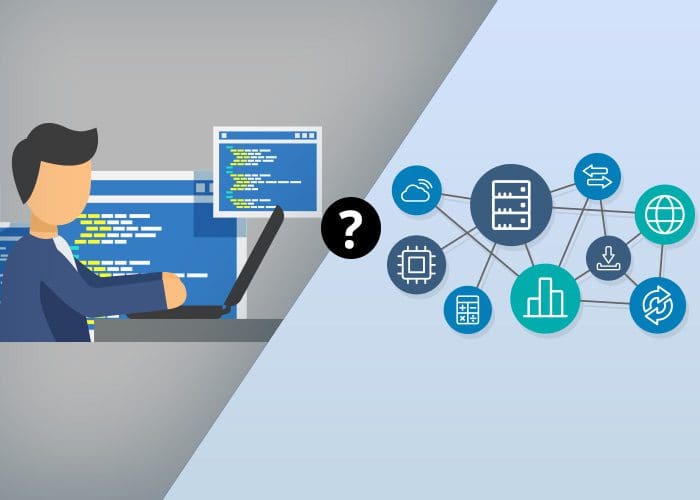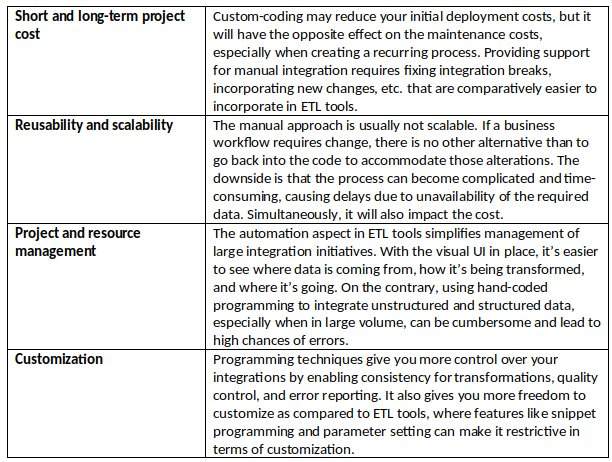Manual Coding or Automated Data Integration – What’s the Best Way to Integrate Your Enterprise Data?
What’s the best way to execute your data integration tasks: writing manual code or using ETL tool? Find out the approach that best fits your organization’s needs and the factors that influence it.
By Tehreem Naeem, Astera

The data-to-insights journey is significant for every organization to make decisions and derive profitable results. And integration is a critical step in that journey that streamlines data processes and makes information accessible to the decision-makers.
Gartner estimates that by 2020, 50% of cost and time in building a digital platform will be dedicated to integration. This means by simplifying integration; you can remove bottlenecks from your data pipeline.
All these challenges make it essential for businesses to adapt data integration as a strategy; one that aligns with your enterprise requirements and objectives. When it comes to selecting the right data integration strategy, the type, volume, and quality of data come into play. Based on these factors and several others, organizations decide whether to go for the manual or automatic approach for integration.
Designing a Data Integration Strategy – Factors to Consider
To design a good data integration strategy, it’s essential to evaluate the scope of your enterprise data and its impact on your plans beyond the initial integration projects. The crux of the matter is that as your company grows, so will your data. Designing an integration strategy that accounts for this growth will help you establish your reputation as a data-driven organization.
These three factors will help you plan a robust data integration strategy:
Long-Term Plans
In the majority of organizations, data integration is the first step towards something bigger, such as migration or data warehousing. For instance, an organization initially looking to integrate their marketing and sales data may have the end goal of creating a master data management system with detailed customer records. Thus the goal of the project should be taken in regard when making the selection.
Cost
Your integration initiatives, whether manual or automatic, will incur costs. This includes the resources for designing, maintaining, and scaling a constant flow of projects if you want to establish your reputation as a data-driven organization. Simultaneously, it may also require a company-wide change in regards to organizational functions, in addition to the technical ones. If you want to modify the data landscape of your company, make sure to work with stakeholders that understand how those changes impact the business and IT users working with data.
Scalability
The ability to integrate new technologies with your existing systems promises tangible improvements for your organization. However, if you lean towards the manual approach, you won’t be able to incorporate these technologies in your data ecosystem without devoting a considerable amount of development time and developer resources. An integration strategy that is scalable enough to accommodate new technological advancements, like cloud-based apps and infrastructure, can bring significant improvements to the organization.
The Manual vs. Automated Dilemma – Finding the Right Approach

The manual vs. automatic approach has forever been a source of debate among data professionals. Organizations favoring the manual approach find it a cost-effective option, whereas ETL tool users are taken by its automation capabilities.
According to data management expert, Rick Sherman, several organizations still lean towards the manual integration approach. It’s a prevalent practice in small and medium-sized businesses. Even some large enterprises use SQL coding and stored procedures to extract and integrate data for reporting and analysis.
What can be the right choice for another organization, maybe a step in the wrong direction for you. To make this more transparent, we have discussed these two approaches based on common deciding factors:

There are merits to both approaches, but the main question is, how do you find the methodology that works for your organization. Consider these questions, and they will help you come to a decision:
Do you have the developer resources to accomplish the integration task?
Good developers are hard to find, especially experts in using new technologies, such as cloud platforms or Hadoop. If a business user and coding novice can accomplish the same task using an ETL tool, and that too using less time, wouldn’t you rather use their expert skills for a more complicated task?
Is this a one-off or a recurring task, or do you plan to expand the scope of the project?
If you are undertaking an integration job using Big Data or analytics, chances are it will be a recurring one. In that case, it may be time-consuming to modify the code or find experts to maintain the tasks to sustain the integration flow. Whereas with one-time tasks, you’d be better off with manual coding.
Will you be able to repurpose the code on a different technology platform?
When planning the project cost and timeline, account for the additional efforts that will be required to re-develop your code according to any new platform in case you decide to incorporate that in your data pipeline. Most of the ETL tools allow easy movement of data from one processing platform to other.
Who will be liable for the maintenance of the integration project?
If you are writing a manual code, your developers will have to take responsibility for not only writing the code but also maintaining it. The latter can be a time-consuming task, making it difficult for them to accommodate other projects.
Does the project involve multiple users?
The visual interface, automation, ease of reusability; these are just some of the factors that make ETL tools a preferred option for integration projects that involve multiple users.
The Takeaway
In today’s world, data integration is one of the fastest ways to acquire business-critical insights and gain a competitive edge. Therefore, it becomes crucial for an organization to select the right strategy and tools to achieve the desired business goals. The simplicity of manual coding makes it an appealing choice, but the automated, straightforward experience of ETL works in the long run. Which integration strategy works for your organization?
Bio: Tehreem Naeem is a technical content strategist at Astera, a data management solution provider, where she creates product-focused content. She holds an electronics engineering degree from a reputable institution and has 7+ years of experience in the field.
Related:
- The Role of the Data Engineer is Changing
- ETL vs ELT: Considering the Advancement of Data Warehouses
- What’s the Difference Between Data Integration and Data Engineering?
